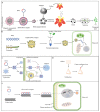Technological Development and Application of Plant Genetic Transformation
- PMID: 37445824
- PMCID: PMC10341552
- DOI: 10.3390/ijms241310646
Technological Development and Application of Plant Genetic Transformation
Abstract
Genetic transformation is an important strategy for enhancing plant biomass or resistance in response to adverse environments and population growth by imparting desirable genetic characteristics. Research on plant genetic transformation technology can promote the functional analysis of plant genes, the utilization of excellent traits, and precise breeding. Various technologies of genetic transformation have been continuously discovered and developed for convenient manipulation and high efficiency, mainly involving the delivery of exogenous genes and regeneration of transformed plants. Here, currently developed genetic transformation technologies were expounded and compared. Agrobacterium-mediated gene delivery methods are commonly used as direct genetic transformation, as well as external force-mediated ways such as particle bombardment, electroporation, silicon carbide whiskers, and pollen tubes as indirect ones. The regeneration of transformed plants usually involves the de novo organogenesis or somatic embryogenesis pathway of the explants. Ectopic expression of morphogenetic transcription factors (Bbm, Wus2, and GRF-GIF) can significantly improve plant regeneration efficiency and enable the transformation of some hard-to-transform plant genotypes. Meanwhile, some limitations in these gene transfer methods were compared including genotype dependence, low transformation efficiency, and plant tissue damage, and recently developed flexible approaches for plant genotype transformation are discussed regarding how gene delivery and regeneration strategies can be optimized to overcome species and genotype dependence. This review summarizes the principles of various techniques for plant genetic transformation and discusses their application scope and limiting factors, which can provide a reference for plant transgenic breeding.
Keywords: Agrobacterium; nanoparticles; particle bombardment; plant genetic transformation.
Conflict of interest statement
The authors declare no conflict of interest.
Figures



Similar articles
-
Unlocking regeneration potential: harnessing morphogenic regulators and small peptides for enhanced plant engineering.Plant J. 2025 Jan;121(2):e17193. doi: 10.1111/tpj.17193. Epub 2024 Dec 10. Plant J. 2025. PMID: 39658544 Free PMC article. Review.
-
Plant Transformation Techniques: Agrobacterium- and Microparticle-Mediated Gene Transfer in Cereal Plants.Methods Mol Biol. 2020;2124:281-294. doi: 10.1007/978-1-0716-0356-7_15. Methods Mol Biol. 2020. PMID: 32277460
-
GRF-GIF chimeric proteins enhance in vitro regeneration and Agrobacterium-mediated transformation efficiencies of lettuce (Lactuca spp.).Plant Cell Rep. 2023 Mar;42(3):629-643. doi: 10.1007/s00299-023-02980-4. Epub 2023 Jan 25. Plant Cell Rep. 2023. PMID: 36695930 Free PMC article.
-
Promoting genotype-independent plant transformation by manipulating developmental regulatory genes and/or using nanoparticles.Plant Cell Rep. 2023 Sep;42(9):1395-1417. doi: 10.1007/s00299-023-03037-2. Epub 2023 Jun 14. Plant Cell Rep. 2023. PMID: 37311877 Free PMC article. Review.
-
Improved cotton transformation protocol mediated by Agrobacterium and biolistic combined-methods.Planta. 2021 Jul 3;254(2):20. doi: 10.1007/s00425-021-03666-5. Planta. 2021. PMID: 34216275
Cited by
-
Advancements in delivery strategies and non-tissue culture regeneration systems for plant genetic transformation.Adv Biotechnol (Singap). 2024 Sep 26;2(4):34. doi: 10.1007/s44307-024-00041-9. Adv Biotechnol (Singap). 2024. PMID: 39883316 Free PMC article. Review.
-
Advancements in plant transformation: from traditional methods to cutting-edge techniques and emerging model species.Plant Cell Rep. 2024 Oct 29;43(11):273. doi: 10.1007/s00299-024-03359-9. Plant Cell Rep. 2024. PMID: 39467894 Review.
-
Advances in Soybean Genetic Improvement.Plants (Basel). 2024 Oct 31;13(21):3073. doi: 10.3390/plants13213073. Plants (Basel). 2024. PMID: 39519991 Free PMC article. Review.
-
Establishment of Agrobacterium-Mediated Transient Transformation System in Sunflower.Plants (Basel). 2025 Aug 4;14(15):2412. doi: 10.3390/plants14152412. Plants (Basel). 2025. PMID: 40805760 Free PMC article.
-
Advances in and Perspectives on Transgenic Technology and CRISPR-Cas9 Gene Editing in Broccoli.Genes (Basel). 2024 May 23;15(6):668. doi: 10.3390/genes15060668. Genes (Basel). 2024. PMID: 38927604 Free PMC article. Review.
References
-
- Ramkumar T.R., Lenka S.K., Arya S.S., Bansal K.C. A Short History and Perspectives on Plant Genetic Transformation. In: Rustgi S., Luo H., editors. Biolistic DNA Delivery in Plants. Humana; New York, NY, USA: 2020. pp. 39–68. - PubMed
-
- Klein T.M. Particle bombardment: An established weapon in the arsenal of plant biotechnologists. In: Stewart C.N., Touraev A., Citovsky V., Tzfira T., editors. Plant Transformation Technologies. Blackwell Publishing Ltd.; Oxford, UK: 2011. pp. 53–71.
Publication types
MeSH terms
Grants and funding
LinkOut - more resources
Full Text Sources
Other Literature Sources

